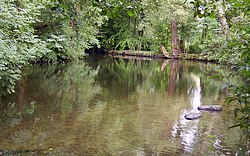
Lower Saxony is a German state in northwestern Germany. It is the second-largest state by land area, with 47,614 km2 (18,384 sq mi), and fourth-largest in population among the 16 Länder of the Federal Republic of Germany. In rural areas, Northern Low Saxon and Saterland Frisian are still spoken, though by declining numbers of people.
Lüneburg is a district in Lower Saxony, Germany. It is bounded by the districts of Lüchow-Dannenberg, Uelzen, Heidekreis and Harburg, and the states of Schleswig-Holstein and Mecklenburg-Western Pomerania.

Lüchow-Dannenberg is a district in Lower Saxony, Germany, which is usually referred to as Hanoverian Wendland or Wendland. It is bounded by the districts of Uelzen and Lüneburg and the states of Mecklenburg-Western Pomerania, Brandenburg and Saxony-Anhalt.
Uelzen is a district in Lower Saxony, Germany. It is bounded by the districts of Gifhorn, Celle, Heidekreis, Lüneburg and Lüchow-Dannenberg, and by the state of Saxony-Anhalt. The district capital is the town of Uelzen.
Celle is a district (Landkreis) in Lower Saxony, Germany. It is bounded by the districts of Uelzen, Gifhorn, Hanover and Heidekreis.
Gifhorn is a district in Lower Saxony, Germany.

Lüneburg Heath is a large area of heath, geest, and woodland in the northeastern part of the state of Lower Saxony in northern Germany. It forms part of the hinterland for the cities of Hamburg, Hanover and Bremen and is named after the town of Lüneburg. Most of the area is a nature reserve. Northern Low Saxon is still widely spoken in the region.

Lüneburg was one of the four Regierungsbezirke of Lower Saxony, Germany, located in the north of the federal state between the three cities Bremen, Hamburg and Hanover.

Uelzen, officially the Hanseatic Town of Uelzen, is a town in northeast Lower Saxony, Germany, and capital of the district of Uelzen. It is part of the Hamburg Metropolitan Region, a Hanseatic town and an independent municipality.

Munster, also called Munster (Örtze) or formerly Munsterlager, is a small town in the district of Heidekreis, in Lower Saxony, Germany almost equidistant from Hamburg and Hanover. The town is home to the German Army's largest garrison and is situated between the two training areas of Munster North and Munster South. It is also the fourth largest garrison in the German Armed Forces. The German Chemical Defence Research Establishment and the Society for the disposal of chemical warfare agents and old armaments GmbH (Ltd.) (GEKA) are located in Munster.

Bad Bevensen is a town in the north of the district Uelzen in Lower Saxony, Germany. It is situated to the east of the Lüneburg Heath. The Ilmenau river, a tributary of the Elbe, flows through Bad Bevensen. Bad Bevensen is a well-known spa town.
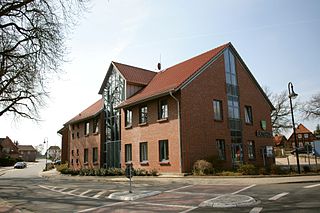
Bienenbüttel is a free municipality in the district of Uelzen, in Lower Saxony, Germany. It is situated on the river Ilmenau, approximately 20 kilometres (12 mi) north of Uelzen, and 13 kilometres (8 mi) southeast of Lüneburg. Bienenbüttel is a part of the Hamburg Metropolitan Region and of the Lüneburg Heath.
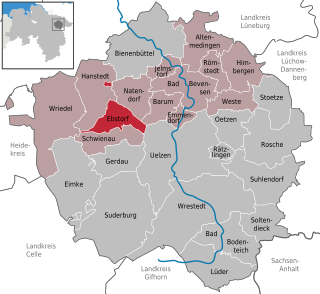
Ebstorf is a municipality in the district of Uelzen, in Lower Saxony, Germany. It is situated approximately 12 kilometres (7.5 mi) northwest of Uelzen, and 25 kilometres (16 mi) south of Lüneburg.

Ilmenau is a Samtgemeinde in the district of Lüneburg, in Lower Saxony, Germany. It is situated along the river Ilmenau, approx. 8 km south of Lüneburg. Its seat is in the village Melbeck.

The Elbe Lateral Canal, is a 115-kilometre (71 mi) long canal in Lower Saxony, Germany. It runs from the Mittelland Canal near Gifhorn to the Elbe in Artlenburg. It forms an important transport connection between southern and northern Germany, and it provides a bypass of a section of the Elbe with limited navigability. At the construction start it was also thought as a bypass outside the GDR, considered politically unreliable.
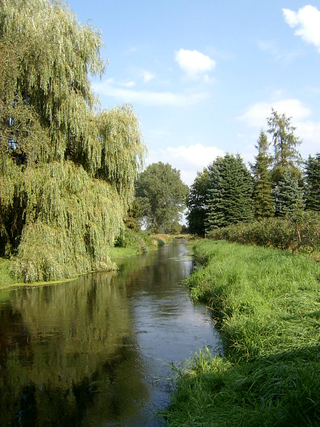
The Gerdau is a 30 km (19 mi) long, left (western) source river for the Ilmenau in the north German state of Lower Saxony.
The Landesliga Lüneburg, called the Bezirksoberliga Lüneburg from 1979 to 1994 and 2006 to 2010, is the sixth tier of the German football league system and the second highest league in the German state of Lower Saxony (German:Niedersachsen). It covers the region of the now defunct Regierungsbezirk Lüneburg.

The Lower Saxon Mill Road is a holiday route that guides visitors to watermills and windmills in the north German state of Lower Saxony and thus links the interests of historic monument conservation with those of the tourist industry.
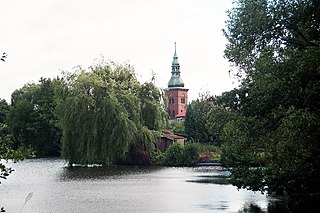
Stederau is a river of Lower Saxony, Germany. It flows into the Ilmenau south of Uelzen.
